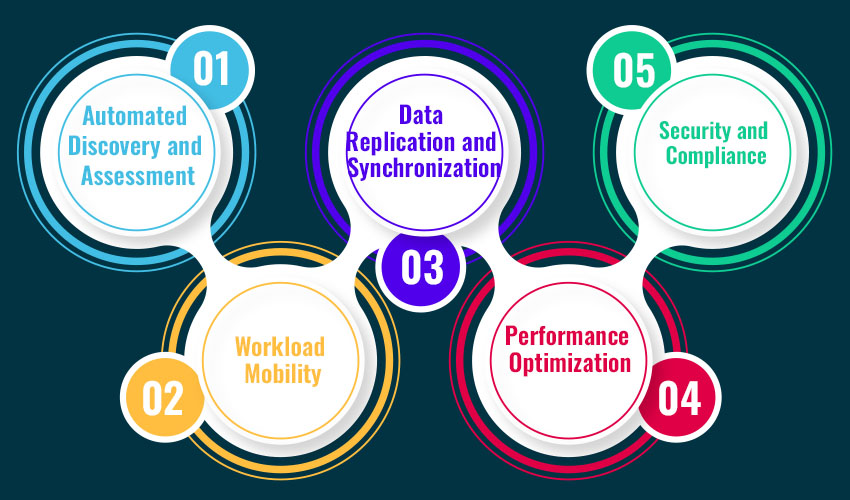Table of Contents
Cloud Migration Services
In today’s rapidly evolving digital landscape, businesses are constantly seeking ways to optimize their operations and enhance their competitive edge. One of the most transformative initiatives gaining traction across industries is cloud migration. As organizations strive to modernize their IT infrastructure, migrate data, and applications to the cloud, the demand for efficient cloud migration services continues to soar.
Cloud migration refers to the process of transferring digital assets such as data, applications, and IT resources from on-premises infrastructure to cloud environments. This strategic move offers numerous benefits, including increased scalability, flexibility, cost savings, and improved performance. However, navigating the complexities of cloud migration requires careful planning, expertise, and the right set of tools.
To facilitate a seamless transition to the cloud, businesses often enlist the support of cloud migration services providers. These specialized firms offer a comprehensive suite of solutions tailored to meet the unique needs and challenges of each organization. From initial assessment and planning to execution and ongoing support, cloud migration service providers play a pivotal role in ensuring a successful migration journey.
- Assessment and Planning: Before embarking on the migration journey, a thorough assessment of existing IT infrastructure, applications, and workloads is conducted. This helps identify dependencies, risks, and migration priorities. Based on the assessment findings, a detailed migration plan outlining timelines, resource allocation, and migration strategies is developed.
- Cloud Strategy and Architecture Design: Cloud migration services providers collaborate with businesses to define a robust cloud strategy aligned with their goals and objectives. This involves selecting the most suitable cloud environment (public, private, or hybrid) and designing an architecture that optimizes performance, security, and cost-efficiency.
- Data Migration: One of the most critical aspects of cloud migration is transferring data securely and efficiently. Cloud migration service providers leverage proven methodologies and tools to facilitate seamless data migration while minimizing downtime and ensuring data integrity.
- Application Migration: Migrating legacy applications to the cloud requires careful planning and execution to avoid disruption to business operations. Cloud migration services providers employ various techniques such as rehosting, re-platforming, and refactoring to modernize and optimize applications for the cloud environment.
- Testing and Validation: Rigorous testing is essential to validate the performance, functionality, and compatibility of migrated workloads in the cloud. Cloud migration services providers conduct comprehensive testing to identify and address any issues or discrepancies before finalizing the migration.
- Optimization and Continuous Improvement: Once the migration is complete, ongoing optimization and monitoring are crucial to maximize the benefits of cloud infrastructure. Cloud migration services providers offer proactive monitoring, performance tuning, and cost optimization services to ensure the cloud environment remains efficient and responsive to evolving business needs.
How to Create a Cloud Migration Services
Cloud migration services have become increasingly popular as businesses look to leverage the benefits of cloud computing. Whether you’re migrating from on-premises infrastructure or from one cloud provider to another, having a well-planned migration strategy is crucial for success. In this article, we’ll outline the steps to create a cloud migration service.
- Understand the Client’s Needs: The first step in creating a cloud migration service is to understand the specific needs and requirements of your clients. This includes understanding their current infrastructure, applications, data, security concerns, compliance requirements, and desired outcomes from the migration.
- Assess the Current Environment: Once you understand the client’s needs, conduct a thorough assessment of their current environment. This includes inventorying existing hardware, software, applications, and data, as well as evaluating performance, scalability, and security considerations.
- Define Migration Goals and Objectives: Based on the assessment, work with the client to define clear migration goals and objectives. These may include cost reduction, increased agility, improved performance, enhanced security, or regulatory compliance.
- Develop a Migration Plan: With the goals and objectives in mind, develop a detailed migration plan outlining the steps, timelines, resources, and responsibilities involved in the migration process. This plan should include a phased approach to minimize disruption to the business and ensure a smooth transition to the cloud.
- Select the Right Cloud Platform: Choose the appropriate cloud platform based on the client’s requirements, such as Amazon Web Services (AWS), Microsoft Azure, Google Cloud Platform (GCP), or others. Consider factors such as cost, performance, scalability, security, compliance, and vendor lock-in when making this decision.
- Design the Cloud Architecture: Design a scalable and resilient cloud architecture that meets the client’s needs and aligns with best practices for cloud computing. This includes designing network architecture, storage solutions, compute resources, security controls, and disaster recovery mechanisms.
- Implement Migration Tools and Technologies: Select and implement migration tools and technologies to automate and streamline the migration process. These may include migration assessment tools, workload migration tools, data migration tools, and monitoring and management solutions.
- Execute the Migration: Once the migration plan and architecture are in place, execute the migration according to the defined timelines and milestones. This may involve migrating applications, data, databases, virtual machines, and other workloads to the cloud environment.
- Test and Validate: After the migration is complete, thoroughly test and validate the migrated workloads to ensure they function as expected in the cloud environment. This includes testing for performance, reliability, security, and compliance.
- Optimize and Manage: Continuously optimize and manage the cloud environment to maximize performance, minimize costs, and ensure security and compliance. This may involve ongoing monitoring, tuning, automation, and governance processes.
Why Should You Go for Cloud Migration Services
In today’s digital age, businesses are constantly looking for ways to streamline their operations and improve efficiency. One solution that has gained popularity in recent years is cloud migration services. Cloud migration involves moving data, applications, and other business elements from on-premises servers to the cloud. There are several reasons why companies should consider investing in cloud migration services.
- Scalability: One of the biggest advantages of cloud migration is scalability. Cloud providers offer flexible pricing models that allow businesses to easily scale their resources up or down based on their needs. This means that companies no longer have to invest in expensive hardware infrastructure that may become obsolete over time.
- Cost savings: Cloud migration can also lead to significant cost savings for businesses. By moving to the cloud, companies can eliminate the need to purchase and maintain expensive hardware, as well as reduce energy consumption and IT overhead costs. Additionally, cloud providers typically offer pay-as-you-go pricing models, allowing businesses to only pay for the resources they use.
- Improved collaboration: Cloud migration enables employees to access data and applications from anywhere with an internet connection. This fosters collaboration among team members, allowing them to work together more efficiently regardless of their location. Additionally, cloud-based collaboration tools often include features such as real-time document editing and instant messaging, further enhancing productivity.
- Enhanced security: Contrary to popular belief, the cloud can actually offer enhanced security compared to on-premises solutions. Cloud providers invest heavily in security measures such as data encryption, access controls, and threat detection, which can help protect sensitive business information from cyber threats. Additionally, cloud providers often have dedicated teams of security experts who continuously monitor and update their systems to mitigate potential risks.
- Disaster recovery and data backup: Cloud migration services typically include robust disaster recovery and data backup solutions. In the event of a natural disaster, hardware failure, or cyber attack, businesses can quickly recover their data and applications from the cloud, minimizing downtime and ensuring business continuity.
Market Prospects of Cloud Migration Services and Platforms
In recent years, the demand for cloud migration services and platforms has seen a significant surge, driven by the growing adoption of cloud computing technologies across various industries. As businesses increasingly recognize the benefits of migrating their operations to the cloud, the market prospects for cloud migration services and platforms continue to expand.
One of the key factors driving the market growth is the need for organizations to modernize their IT infrastructure and leverage the scalability, flexibility, and cost-efficiency offered by cloud platforms. Cloud migration allows businesses to move their applications, data, and workloads from on-premises environments to the cloud, enabling them to streamline operations, improve agility, and enhance overall business performance.
Moreover, the COVID-19 pandemic has accelerated the adoption of cloud technologies as remote work and digital transformation initiatives have become imperative for businesses to survive and thrive in the new normal. This has further fueled the demand for cloud migration services and platforms, as organizations seek to optimize their digital infrastructure and support remote collaboration and productivity.
Another driving factor is the increasing complexity of IT environments, with businesses operating across multiple cloud platforms, hybrid cloud environments, and on-premises infrastructure. This complexity presents challenges in terms of interoperability, data integration, security, and compliance, driving the need for specialized cloud migration services and tools to facilitate seamless migrations and ensure a smooth transition to the cloud.
Furthermore, advancements in cloud migration technologies, such as automation, machine learning, and AI-driven analytics, are enabling more efficient and cost-effective migration processes, further driving market growth. These technologies help organizations assess their existing infrastructure, identify workloads suitable for migration, automate migration tasks, and optimize cloud resources for maximum performance and cost savings.
In terms of market dynamics, the cloud migration services and platforms market is highly competitive, with a plethora of vendors offering a wide range of solutions to cater to the diverse needs of businesses. Key players in the market include cloud service providers such as Amazon Web Services (AWS), Microsoft Azure, Google Cloud Platform (GCP), as well as specialized cloud migration vendors and consulting firms.
Essential Features of a Cloud Migration Services
In today’s digital age, businesses are increasingly turning to cloud migration services to leverage the benefits of cloud computing. Cloud migration involves moving data, applications, and other business elements from on-premises infrastructure to cloud-based platforms. However, not all cloud migration services are created equal. To ensure a successful and efficient migration process, it’s essential to look for certain key features in a cloud migration service provider.
- Comprehensive Assessment and Planning: Before embarking on a cloud migration journey, it’s crucial to conduct a thorough assessment of the existing infrastructure, applications, and data. A reliable cloud migration service provider will offer comprehensive assessment services to identify potential challenges, risks, and opportunities associated with the migration. Additionally, they will help develop a detailed migration plan tailored to the specific needs and goals of the business.
- Seamless Migration Process: A successful cloud migration requires a seamless transition from the on-premises environment to the cloud platform. Look for a service provider that offers expertise in migrating various types of workloads, including legacy applications, databases, and infrastructure components. They should have proven methodologies and tools to ensure minimal disruption to business operations during the migration process.
- Security and Compliance: Security is paramount when it comes to migrating sensitive data and applications to the cloud. A reputable cloud migration service provider will prioritize security at every step of the migration process. They should adhere to industry best practices and compliance standards to protect data integrity and confidentiality. Look for certifications such as ISO 27001 and SOC 2 to ensure the service provider meets rigorous security standards.
- Scalability and Flexibility: One of the primary benefits of cloud computing is its scalability and flexibility. A reliable cloud migration service provider will help businesses leverage the scalability features of the cloud to accommodate changing business needs and growth requirements. They should offer flexible migration options, allowing businesses to migrate at their own pace and scale resources up or down as needed.
- Ongoing Support and Maintenance: Cloud migration is not a one-time event but rather an ongoing process. Choose a service provider that offers continuous support and maintenance post-migration. This includes monitoring performance, optimizing resource utilization, and addressing any issues or challenges that may arise in the cloud environment. A proactive approach to support and maintenance will ensure the long-term success of your cloud migration initiative.
Advanced Features of Cloud Migration Services
Cloud migration services have become increasingly popular among businesses looking to modernize their IT infrastructure and leverage the benefits of cloud computing. These services not only help organizations move their applications and data to the cloud but also offer advanced features to optimize the migration process and enhance overall efficiency. In this article, we’ll explore some of the advanced features of cloud migration services that are shaping the future of cloud adoption.
- Automated Discovery and Assessment: Leading cloud migration services offer automated tools for discovering and assessing on-premises infrastructure, applications, and data. These tools use advanced algorithms to analyze dependencies, performance metrics, and compatibility issues, providing organizations with valuable insights into their migration readiness and potential challenges. By automating the discovery and assessment process, businesses can accelerate decision-making and reduce the risk of migration errors.
- Workload Mobility: Cloud migration services enable seamless workload mobility across different cloud environments, including public, private, and hybrid clouds. With advanced migration capabilities, organizations can move workloads between on-premises data centers and cloud platforms without disrupting operations or compromising performance. Workload mobility features also facilitate cloud bursting, disaster recovery, and load balancing, allowing businesses to dynamically scale their infrastructure to meet changing demands.
- Data Replication and Synchronization: Data replication and synchronization are critical components of cloud migration, ensuring that data remains consistent and available throughout the migration process. Advanced cloud migration services offer robust replication and synchronization features that allow organizations to replicate data in real-time or near-real-time between on-premises and cloud environments. This enables continuous data access and minimizes downtime during migration, enhancing business continuity and data integrity.
- Performance Optimization: To maximize the performance of applications and workloads in the cloud, migration services provide advanced performance optimization features. These features include automated resource provisioning, workload balancing, and performance monitoring tools that optimize cloud infrastructure based on workload requirements and usage patterns. By leveraging performance optimization capabilities, businesses can achieve higher levels of efficiency, scalability, and cost-effectiveness in the cloud.
- Security and Compliance: Security and compliance are top priorities for organizations migrating to the cloud, and advanced migration services offer robust security and compliance features to address these concerns. These features include data encryption, identity and access management, network security controls, and compliance reporting tools that help organizations maintain regulatory compliance and protect sensitive data in the cloud. By integrating security and compliance into the migration process, businesses can mitigate risks and build trust with customers and stakeholders.
Cloud Migration Services Timelines
Cloud migration services timelines play a crucial role in the successful transition of businesses from on-premises infrastructure to cloud-based environments. As more organizations recognize the benefits of cloud computing, such as scalability, flexibility, and cost-efficiency, they are increasingly turning to cloud migration services to facilitate their journey to the cloud. However, without proper planning and adherence to timelines, the migration process can become chaotic and disruptive to business operations.
Timelines for cloud migration services typically vary depending on the complexity of the organization’s infrastructure, the size of the data being migrated, and the chosen cloud service provider. However, there are some common phases and milestones that businesses can expect when undergoing a cloud migration:
- Assessment and Planning:
- The first phase involves assessing the current infrastructure, applications, and data to determine their suitability for migration to the cloud.
- This phase also includes identifying business objectives, defining migration strategies, and establishing timelines and budgets for the migration project.
- Pre-Migration Preparation:
- During this phase, organizations prepare their existing systems and applications for migration by addressing any compatibility issues, optimizing performance, and conducting necessary data cleansing and archiving.
- This phase may also involve training staff on cloud technologies and best practices to ensure a smooth transition.
- Migration Execution:
- The actual migration of data, applications, and workloads to the cloud takes place during this phase.
- Depending on the migration strategy chosen (lift-and-shift, re-platforming, or re-architecting), this phase may involve different levels of complexity and resource requirements.
- Testing and Validation:
- Once the migration is complete, thorough testing is conducted to ensure that all applications and workloads are functioning as expected in the cloud environment.
- This phase may also involve validating security measures, compliance requirements, and disaster recovery mechanisms.
- Optimization and Post-Migration Support:
- After the migration, organizations focus on optimizing their cloud infrastructure for performance, cost-effectiveness, and scalability.
- Ongoing support and monitoring are essential to address any issues that may arise post-migration and to ensure the continued success of the cloud environment.
It’s important to note that the timelines for each phase of the cloud migration process can vary depending on factors such as the size of the organization, the complexity of its infrastructure, and the level of expertise of the migration team. However, a well-planned and executed migration project typically takes several weeks to several months to complete.
How Much Does It Cost to Build a Cloud Migration Service?
Cloud migration services have become increasingly essential for businesses looking to move their operations to the cloud, whether partially or entirely. However, one common concern that arises when considering cloud migration is the cost involved. Understanding the factors that contribute to the cost of building cloud migration services can help businesses budget effectively and make informed decisions.
The cost of building cloud migration services can vary significantly depending on several factors, including the size and complexity of the organization, the amount of data to be migrated, the specific cloud service provider chosen, and the level of customization required. Here’s a breakdown of some key cost considerations:
- Consultation and Assessment: Before beginning the migration process, it’s crucial to conduct a thorough assessment of the existing infrastructure, applications, and data. This often involves engaging with consultants or experts who can analyze the current state of IT systems and recommend the best approach for migration. The cost of consultation and assessment services can vary based on the scope of the project and the expertise of the consultants involved.
- Infrastructure and Tools: Building cloud migration services typically requires investment in infrastructure and tools that facilitate the migration process. This may include software for data migration, automation tools, and cloud management platforms. The cost of these tools can vary depending on the vendor and the specific features required.
- Data Transfer and Storage: Migrating large volumes of data to the cloud can incur costs related to data transfer and storage. Cloud service providers often charge based on the amount of data transferred and stored, as well as any network egress fees incurred during the migration process. Businesses need to estimate the size of their data and budget accordingly for these costs.
- Training and Education: Transitioning to the cloud may require training and education for IT staff and end-users to ensure they understand how to effectively utilize the new cloud-based infrastructure and services. Investing in training programs or hiring external trainers can add to the overall cost of cloud migration.
- Integration and Customization: Depending on the complexity of existing IT systems and applications, integration and customization efforts may be required to ensure seamless migration to the cloud. This could involve modifying existing applications, building new APIs, or integrating with third-party services. The cost of integration and customization will depend on the extent of changes needed and the expertise required.
- Ongoing Support and Maintenance: Once the migration is complete, businesses will need to budget for ongoing support and maintenance of their cloud infrastructure. This may include monitoring and managing cloud resources, troubleshooting issues, and implementing updates and patches. The cost of ongoing support and maintenance can vary depending on whether businesses choose to manage it internally or outsource to a managed service provider.
How to Create a Cloud Migration Services – Team and Tech Stack
Cloud migration services have become increasingly essential for businesses looking to modernize their IT infrastructure and leverage the benefits of cloud computing. Whether it’s moving data, applications, or entire systems to the cloud, having the right team and technology stack in place is crucial for a successful migration process. In this article, we’ll explore how to create a cloud migration services team and the technology stack needed to support them.
- Team Composition:
- Project Manager: Oversees the entire migration process, including planning, execution, and post-migration support.
- Cloud Architect: Designs the cloud infrastructure and ensures it meets the organization’s needs in terms of scalability, security, and performance.
- Systems Administrators: Responsible for configuring, deploying, and managing the cloud environment.
- DevOps Engineers: Automate the deployment and management processes to streamline operations and improve efficiency.
- Security Experts: Implement security measures to protect data and applications during and after migration.
- Quality Assurance/Testers: Conduct testing to ensure that migrated applications function properly in the cloud environment.
- Technology Stack:
- Cloud Platforms: Choose a cloud provider such as Amazon Web Services (AWS), Microsoft Azure, or Google Cloud Platform (GCP) based on your organization’s requirements and preferences.
- Migration Tools: Utilize tools like AWS Server Migration Service, Azure Migrate, or CloudEndure for seamless migration of virtual machines, databases, and applications to the cloud.
- Containerization: Adopt containerization technologies like Docker and Kubernetes to package and deploy applications consistently across different cloud environments.
- Infrastructure as Code (IaC): Implement tools like Terraform or AWS CloudFormation to automate the provisioning and management of cloud infrastructure.
- Monitoring and Logging: Set up monitoring and logging tools such as AWS CloudWatch, Azure Monitor, or Google Cloud Monitoring to track the performance and health of your cloud resources.
- Security Solutions: Employ cloud-native security services like AWS Identity and Access Management (IAM), Azure Active Directory, or Google Cloud Identity and Access Management (IAM) to manage user access and permissions.
- Networking Services: Configure networking services like Virtual Private Cloud (VPC), Azure Virtual Network, or Google Virtual Private Cloud (VPC) to establish secure connections between on-premises and cloud environments.
- Best Practices:
- Conduct a thorough assessment of your current infrastructure and workloads to determine the most suitable migration strategy (lift and shift, re-platforming, or re-architecting).
- Develop a detailed migration plan with clear objectives, timelines, and milestones to ensure a smooth transition to the cloud.
- Prioritize security throughout the migration process by implementing encryption, access controls, and other security measures.
- Test applications and workloads in the cloud environment before fully migrating them to identify and address any compatibility or performance issues.
- Provide training and support for your team members to ensure they have the necessary skills and knowledge to manage the cloud environment effectively.
Cloud Migration Services Process
Cloud migration services have become increasingly popular as businesses look to harness the power and flexibility of cloud computing. However, the process of migrating to the cloud can be complex and challenging without the right strategy and expertise in place. In this article, we will explore the cloud migration services process, including key steps and considerations for a successful migration.
- Assessment and Planning: The first step in the cloud migration process is to assess your current IT infrastructure and determine which workloads and applications are suitable for migration to the cloud. This involves identifying dependencies, performance requirements, security concerns, and any regulatory compliance issues. Once this assessment is complete, a detailed migration plan can be developed, outlining the timeline, resources, and objectives of the migration project.
- Choosing the Right Cloud Provider: Selecting the right cloud provider is critical to the success of your migration project. Factors to consider include the provider’s reliability, performance, security features, compliance certifications, and pricing model. It’s essential to evaluate multiple providers and choose one that aligns with your specific requirements and objectives.
- Data Migration: Data migration is one of the most critical aspects of the cloud migration process. This involves transferring data from on-premises systems to the cloud infrastructure while ensuring minimal downtime and data integrity. Depending on the volume of data and the complexity of your environment, different migration methods such as lift-and-shift, re-platforming, or refactoring may be employed.
- Application Migration: In addition to data migration, you’ll also need to migrate your applications to the cloud environment. This may involve rearchitecting applications to take advantage of cloud-native services, such as serverless computing or containerization. It’s essential to thoroughly test applications in the cloud environment to ensure compatibility, performance, and security.
- Testing and Validation: Once data and applications are migrated to the cloud environment, thorough testing and validation are necessary to ensure everything functions as expected. This includes performance testing, security testing, and user acceptance testing to identify and address any issues or bottlenecks before fully transitioning to the cloud.
- Deployment and Optimization: After successful testing and validation, the final step is to deploy your workloads and applications in the cloud environment. Continuous monitoring and optimization are essential to ensure optimal performance, cost efficiency, and security posture in the cloud. This may involve implementing automation tools, scaling resources dynamically, and optimizing configurations based on workload demands.
Next Big Technology – Your Trusted Cloud Migration Services Partner
In today’s fast-paced digital landscape, businesses are constantly looking for ways to optimize their operations and stay ahead of the competition. One key aspect of this optimization is migrating to the cloud, which offers scalability, flexibility, and cost-efficiency. However, navigating the complexities of cloud migration can be daunting without the right expertise and support. That’s where Next Big Technology comes in as your trusted cloud migration services partner.
At Next Big Technology, we understand that every business has unique needs and challenges when it comes to migrating to the cloud. Whether you’re a small startup or a large enterprise, our team of experienced cloud experts is dedicated to providing personalized solutions tailored to your specific requirements.
We offer a comprehensive range of cloud migration services, including assessment and planning, data migration, application migration, and post-migration support. Our proven methodology ensures a seamless transition to the cloud with minimal disruption to your business operations.
What sets us apart from other cloud migration service providers is our commitment to excellence and customer satisfaction. We prioritize transparency, communication, and collaboration throughout the entire migration process, keeping you informed every step of the way.
In addition to our technical expertise, we also place a strong emphasis on security and compliance. We adhere to industry best practices and regulatory standards to ensure that your data remains secure and compliant with applicable regulations.
Furthermore, we understand the importance of cost optimization in today’s competitive business environment. That’s why we work closely with you to identify cost-saving opportunities and optimize your cloud infrastructure for maximum efficiency and ROI.
When you choose Next Big Technology as your cloud migration services partner, you can trust that you’re in good hands. Our team is dedicated to delivering exceptional results and helping you unlock the full potential of the cloud.
Enterprise Cloud Migration Services
Enterprise cloud migration services have become increasingly vital as businesses look to leverage the benefits of cloud computing. With the rapid evolution of technology and the growing demands of modern business operations, many organizations are migrating their IT infrastructure and applications to the cloud to enhance agility, scalability, and cost-effectiveness.
Cloud migration refers to the process of moving digital assets, such as data, applications, and workloads, from on-premises infrastructure to cloud-based environments. This shift allows businesses to access computing resources on-demand, without the need for investing in and managing physical hardware. Enterprise cloud migration services facilitate this transition by providing expertise, tools, and support throughout the migration journey.
There are several key benefits that organizations can realize through enterprise cloud migration services:
- Cost Savings: By migrating to the cloud, businesses can reduce capital expenditures on hardware and infrastructure maintenance. Cloud services typically operate on a pay-as-you-go model, allowing companies to scale resources up or down based on their needs, thus optimizing costs.
- Scalability and Flexibility: Cloud environments offer unparalleled scalability, allowing businesses to quickly adapt to changing demands and scale resources as needed. This flexibility enables organizations to innovate faster and stay ahead of the competition.
- Improved Security and Compliance: Enterprise cloud migration services often include robust security measures and compliance frameworks to protect sensitive data and ensure regulatory compliance. Cloud providers invest heavily in security infrastructure, offering advanced encryption, access controls, and threat detection capabilities.
- Enhanced Performance and Reliability: Cloud platforms are built on robust infrastructure with redundant systems, ensuring high availability and reliability. Additionally, cloud providers offer global data centers, enabling businesses to deliver fast and consistent performance to users around the world.
- Simplified Management and Maintenance: Cloud migration services streamline IT management by offloading routine maintenance tasks to the cloud provider. This allows IT teams to focus on strategic initiatives rather than spending time on infrastructure upkeep.
To successfully migrate to the cloud, organizations often partner with experienced cloud migration service providers. These providers offer a range of services, including assessment and planning, workload migration, data migration, application modernization, and ongoing support and optimization.
During the migration process, careful planning and execution are essential to minimize disruptions to business operations and ensure a smooth transition. This includes assessing current infrastructure, identifying workloads suitable for migration, establishing migration priorities, and implementing a phased approach to minimize risk.
Top Cloud Migration Services Company
Are you looking to migrate your business to the cloud? If so, you’ll want to partner with a top cloud migration services company to ensure a smooth and successful transition. With so many options available, it can be challenging to choose the right provider. To help you make an informed decision, let’s take a closer look at some of the top cloud migration services companies in the industry.
-
-
Next Big Technology:

Focus Area
- Mobile App Development
- App Designing (UI/UX)
- Software Development
- Web Development
- AR & VR Development
- Big Data & BI
- Cloud Computing Services
- DevOps
- E-commerce Development
Industries Focus
- Art, Entertainment & Music
- Business Services
- Consumer Products
- Designing
- Education
- Financial & Payments
- Gaming
- Government
- Healthcare & Medical
- Hospitality
- Information Technology
- Legal & Compliance
- Manufacturing
- Media
-
- IBM Cloud Migration Services: IBM is another top player in the cloud migration services market, providing end-to-end solutions to help businesses migrate to the cloud securely and efficiently. Their team of experts can assist with everything from planning and assessment to migration and optimization, ensuring a seamless transition to the cloud.
- Amazon Web Services (AWS) Migration Services: As one of the largest cloud providers in the world, AWS offers a comprehensive suite of migration services to help businesses move their workloads to the cloud. With AWS Migration Services, you can take advantage of tools and resources designed to simplify the migration process and minimize downtime.
- Microsoft Azure Migration Services: Microsoft Azure is another popular choice for cloud migration, offering a range of services to help businesses move to the cloud with confidence. With Azure Migration Services, you can leverage Microsoft’s expertise and technology to migrate your applications, data, and infrastructure seamlessly.
- Google Cloud Migration Services: Google Cloud Platform (GCP) offers a variety of migration services to help businesses modernize their IT infrastructure and drive innovation in the cloud. From lift-and-shift migrations to application modernization, Google Cloud Migration Services can help you achieve your cloud migration goals efficiently.
Add Comparison Table Cloud Migration Services
In today’s fast-paced digital landscape, businesses are increasingly adopting cloud computing to streamline operations, enhance scalability, and reduce costs. Cloud migration services play a crucial role in helping organizations seamlessly transition their IT infrastructure and applications to the cloud. With numerous providers in the market, choosing the right cloud migration service can be daunting. In this article, we’ll compare some of the top cloud migration services to help you make an informed decision.
| Features | AWS Migration Hub | Azure Migrate | Google Cloud Migrate |
|---|---|---|---|
| Supported Platforms | AWS, On-premises | Azure, On-premises | Google Cloud |
| Assessment Tools | Yes | Yes | Yes |
| Automated Migration | Yes | Yes | Yes |
| Data Transfer Options | Online, Offline | Online, Offline | Online, Offline |
| Cost Estimation | Yes | Yes | Yes |
| Migration Monitoring | Yes | Yes | Yes |
| Post-Migration Support | Yes | Yes | Yes |
AWS Migration Hub: AWS Migration Hub is a centralized service that allows organizations to monitor and manage migrations across multiple AWS services. It provides assessment tools to evaluate application readiness for migration, automated migration capabilities, and cost estimation features. With AWS Migration Hub, users can track the progress of migrations in real-time and access post-migration support.
Azure Migrate: Azure Migrate simplifies the migration process to Microsoft Azure by offering assessment, migration, and optimization tools. It supports migrations from on-premises environments as well as other cloud platforms to Azure. Azure Migrate provides comprehensive assessment reports, automated migration capabilities, and ongoing monitoring to ensure a smooth transition. Additionally, it offers cost estimation features to help users plan their migration budgets effectively.
Google Cloud Migrate: Google Cloud Migrate is a suite of tools designed to facilitate seamless migrations to Google Cloud Platform (GCP). It supports migrations from on-premises environments and other cloud providers to GCP. Google Cloud Migrate offers assessment tools to evaluate workload suitability for migration, automated migration capabilities, and data transfer options for online and offline migrations. It also provides cost estimation features and ongoing monitoring to optimize performance post-migration.
















